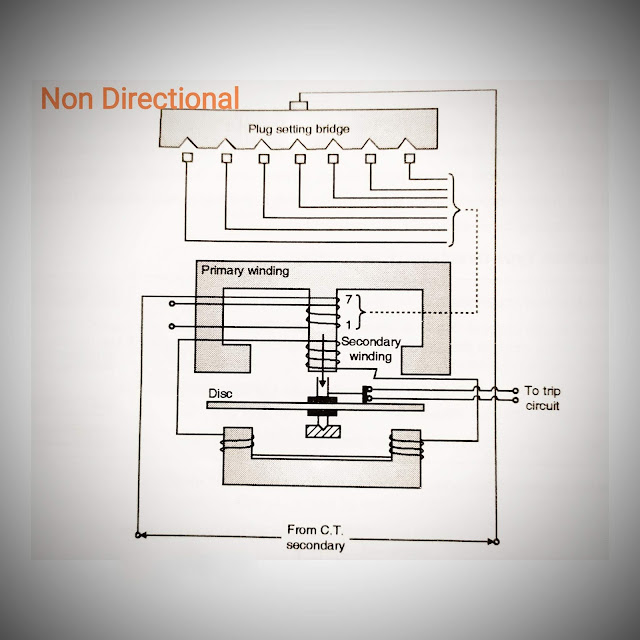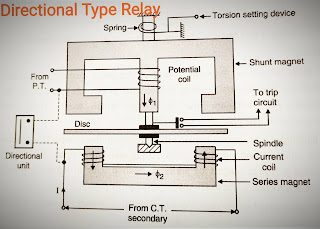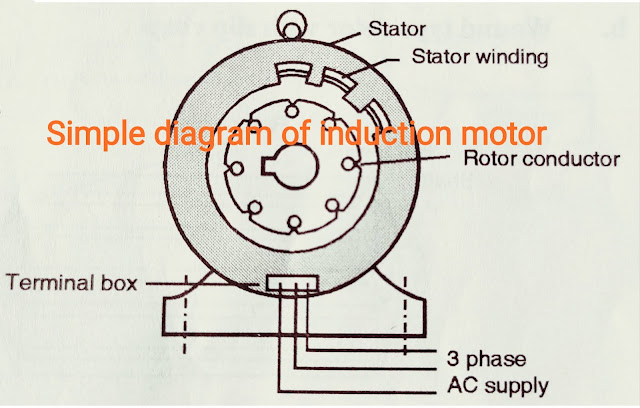Induction type Over Current Relay
Induction type Over Current Relay
Induction type Over Current Relay(Non Directional) :-
Construction:-
- The relay works on induction principle. Actuating quantity is current (from CT secondary). The primary winding is connected to secondary of C. T. in the line to be protected. An aluminum disc is pivoted which moves freely between two electromagnets. The primary is tapped (1...... 7).
- Tne tappings are connected to plug setting bridge so that number of active turns on relay can be changed and desired current setting can be obtained. Secondary winding is connected to lower magnet by series connection. Due to induction principle e. m. f is induced in secondary due to current in primary.
- The torque exerted on the disc is due to interaction of eddy-currents in the disc and flux produced by upper and lower magnet.
- The two fluxes have phase displacement. The spindle carries moving contact which bridges the two fixed contacts which are connected to trip circuit. The moving contact move through a preset angle. By adjusting this angle (from O ° to 360°) travel of moving contact can be adjusted and hence time setting is also possible. Restraining torque is provided with the help of spring.
Operation:-
- Torque is produced on A1 disc due to interaction of eddy current in the disc and two fluxes produced by upper and lower magnet. In normal working conditions, torque driving is higher than torque driving produced by the current relay coil. So the A1 disk does not spin. If current exceeds preset value, driving torque is greater than restraining Torque. And disc rotates through preset angle causing bridging of trip circuit contacts. The trip circuit operates causing the opening of C. B., fault is cleared.
Induction type Over Current Relay(Directional) :-
- Directional feature is important in protection scheme. The protection scheme operates on the basis of magnitude and phase as well as direction of flow of actuating quantity. This is useful particulary is protection against revers power flow construction.
Above fig Shows induction type direcaonal relay.
- It consists of two electromagnets:-
(I) Shunt magnet (E shaped) which is excited by output of PT
(ii) Series magnet (C shaped) which is excited by output of CT
- A directional unit is added in the circuit. The directional unit controls the angle between the two fluxes.
- An aluminium disc is suspended between the two electromagnets and it is supported by a spindle.
- A Spirally wounds spring along with torsion head is provided. It performs two functions.
- Produces controlling torque on Relay.
- Provides leads for connection from moving contacts.
Working:-
- The two fluxes are proportional to voltage and current respectively. These alternating fluxes link with aluminium disc and eddy currents are induced in aluminium disc.These eddy current interact with two fluxes to produce torque on the disc.
- The directional unit adjusts two fluxes, such that under normal working conditions, there is no torque produced on the aluminum disc. Wnen direction of power flow changes, the directional units adjusts Flux1 and Flux2,such that torque is produced on the disc and it rotates. Due to rotation, the trip circuit contacts are closed and relay sends trip signal to circuit breaker and circuit breaker operates.
Directional relays should process following features:-
- High sensitivity
- High speed of operation
- Less burden
- Free from voltage and current creep




Comments
Post a Comment